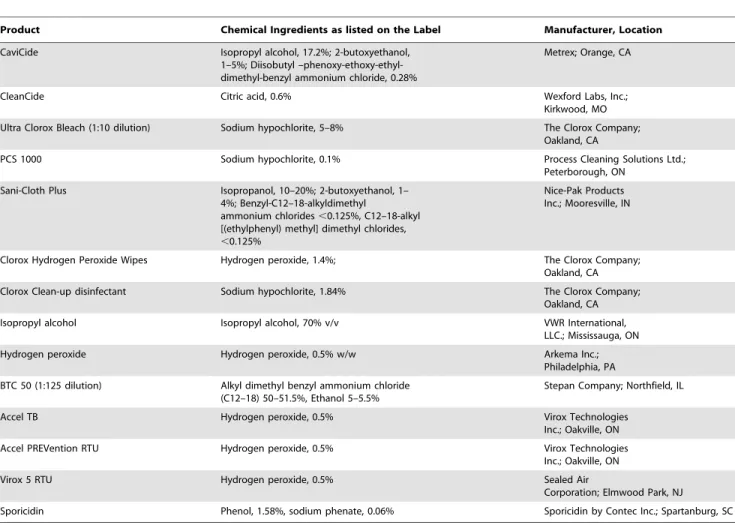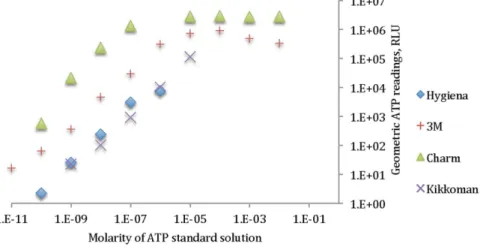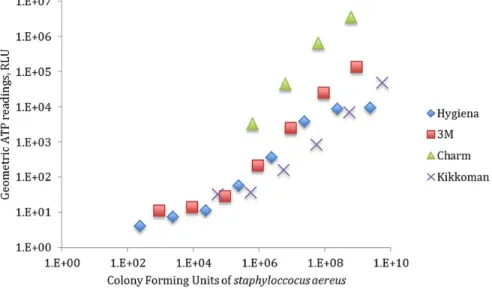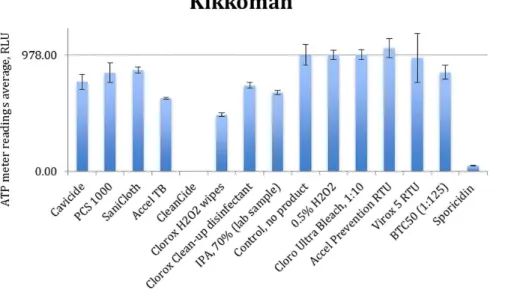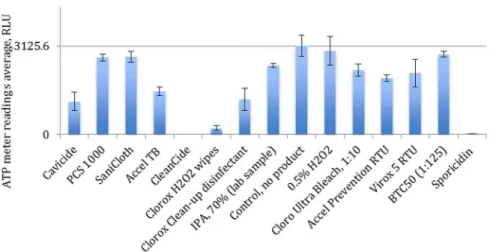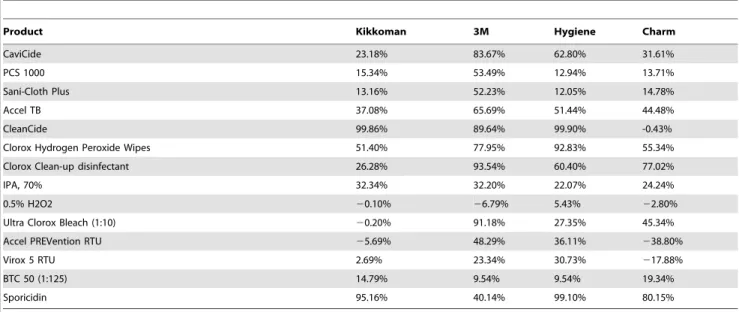Assessing Decontamination of Environmental Surfaces in
Healthcare Settings?
Navid Omidbakhsh1* , Faraz Ahmadpour1 , Nicole Kenny2
1Research & Development, Virox Technologies, Inc., Oakville, Ontario, Canada,2Professional & Technical Services, Virox Technologies Inc., Oakville, Ontario, Canada
Abstract
Background:Meters based on adenosine triphosphate (ATP) bioluminescence measurements in relative light units (RLU) are often used to rapidly assess the level of cleanliness of environmental surfaces in healthcare and other settings. Can such ATP measurements be adversely affected by factors such as soil and cleaner-disinfectant chemistry?
Objective:This study tested a number of leading ATP meters for their sensitivity, linearity of the measurements, correlation of the readings to the actual microbial contamination, and the potential disinfectant chemicals’ interference in their readings.
Methods:First, solutions of pure ATP in various concentrations were used to construct a standard curve and determine linearity and sensitivity. Serial dilutions of a broth culture of Staphylococcus aureus, as a representative nosocomial
pathogen, were then used to determine if a given meter’s ATP readings correlated with the actual CFUs. Next, various types of disinfectant chemistries were tested for their potential to interfere with the standard ATP readings.
Results:All four ATP meters tested herein demonstrated acceptable linearity and repeatability in their readings. However, there were significant differences in their sensitivity to detect the levels of viable microorganisms on experimentally contaminated surfaces. Further, most disinfectant chemistries tested here quenched the ATP readings variably in different ATP meters evaluated.
Conclusions:Apart from their limited sensitivity in detecting low levels of microbial contamination, the ATP meters tested were also prone to interference by different disinfectant chemistries.
Citation:Omidbakhsh N, Ahmadpour F, Kenny N (2014) How Reliable Are ATP Bioluminescence Meters in Assessing Decontamination of Environmental Surfaces in Healthcare Settings? PLoS ONE 9(6): e99951. doi:10.1371/journal.pone.0099951
Editor:Marie-Joelle Virolle, University Paris South, France
ReceivedJanuary 29, 2014;AcceptedMay 21, 2014;PublishedJune 18, 2014
Copyright:ß2014 Omidbakhsh et al. This is an open-access article distributed under the terms of the Creative Commons Attribution License, which permits unrestricted use, distribution, and reproduction in any medium, provided the original author and source are credited.
Funding:Virox Technologies provided support in the form of salaries for authors Navid Omidbakhsh, Faraz Ahmadpour and Nicole Kenny, but did not have any additional role in the study design, data collection and analysis, decision to publish, or preparation of the manuscript. The specific roles of these authors are articulated in the ‘author contributions’ section.
Competing Interests:The authors have the following interests: This study was funded by Virox Technologies Inc. Two of the authors (Faraz Ahmadpour and Nicole Kenny) are employed by Virox Technologies Inc. The third author, Navid Omidbakhsh, used to be an employee of Virox Technologies at the time of submitting this manuscript, but not anymore. The authors hold the following patents, which are owned by Virox Technologies: Hydrogen peroxide disinfectant with increased activity US 6,346,279, US 6,803,057 (CIP), EP 1139762 B1, CA 2344471, AU 741104, AT225128, BR9915987, DE69903347, JP3350526. Enhanced activity hydrogen peroxide disinfectant US 7,632,523, NZ0534352A, AU3245498 AA, CA2475327, EP1473998A1. Enhanced activity hydrogen peroxide disinfectant 13/410737. Hydrogen Peroxide Disinfectant Containing a Cyclic Carboxylic acid and/or an Aromatic Alcohol US 7,354,604, EP1562430B1, CA2503627AA, AU 2003302067, JP 4813059. Hydrogen Peroxide Disinfectant Containing a Cyclic Carboxylic acid and/or an Aromatic Alcohol EP 1 955 593 B1. Low foaming hydrogen peroxide solutions for organic soils US 6,686,324, CA 23661741, CA 2454437. Hydrogen peroxide-based skin disinfectant 13/022683, NZ 550744, AU2005244462, CA 2564763. Antimicrobial compositions 60/955,991, WO 2009021336, EP2182811A1. Concentrated Hydrogen Peroxide disinfecting solutions US 8,591,958 B2, CA 2,733,644, 09817139.0, EP2329002B1, NZ 591314, 2011-528154. Virox is the creator and manufacturer of cleaning and disinfecting chemicals based on our patented accelerated hydrogen peroxide technology. Virox is not directly or indirectly associated with the sale or support ATP meters. This does not alter the authors’ adherence to PLOS ONE policies on sharing data and materials.
* E-mail: navid.omidbakhsh@gmail.com
.
Introduction
Several types of pathogens can readily survive on high-touch environmental surfaces in healthcare and other settings [1–4] as a result these surfaces may act as vehicles for the spread of a variety of nosocomial pathogens [3,5]. In 2002 in the US, 5% of all patients acquired such infections and of these, the mortality rate was nearly 6% [6–11]. In the United States alone, the cost of such
hospital-acquired infections (HAIs) is estimated to be between 5 and 29 billion dollars annually [9,12–14].
To limit the impact of HAIs, routine cleaning and disinfection of high-touch environmental surfaces in healthcare facilities is crucial for infection control [2,4,15–19]. In addition, it is imperative to ascertain that the decontamination procedures in such facilities are optimal. While the widely used practice of visual inspections may be sufficient for aesthetic purposes, it does not
" "
Materials and Methods
Test Materials
ATP bioluminescence meters: Kikkoman Lumitester PD-20 from Luminultra Technologies Ltd. (with LuciPac Pen swabs), EnSURE Hygiene Meter – ATP-205 from Hygiena/Scigiene Corporation (with ATP3000 SuperSnap swabs), Clean-Trace NG Luminometer UNG2 from 3M Company (with Surface ATP
-Methods
First, the ATP luminometer meters were tested for their linearity in reading standard ATP solutions. A 0.1 molar solution of ATP standard powder was prepared in autoclaved deionized (DI) water, followed by serial 10-fold dilutions from 1022to 10210. 10mL of each dilution was pipetted directly onto the swab tip using positive displacement tips. This was done to avoid the variability resulting from the difference of swab-to-swab efficiency in picking up the organic load from the surface. Each meter
Table 1.Tested disinfectants, their active ingredients, and manufacturers.
Product Chemical Ingredients as listed on the Label Manufacturer, Location
CaviCide Isopropyl alcohol, 17.2%; 2-butoxyethanol, 1–5%; Diisobutyl –phenoxy-ethoxy-ethyl-dimethyl-benzyl ammonium chloride, 0.28%
Metrex; Orange, CA
CleanCide Citric acid, 0.6% Wexford Labs, Inc.;
Kirkwood, MO
Ultra Clorox Bleach (1:10 dilution) Sodium hypochlorite, 5–8% The Clorox Company; Oakland, CA
PCS 1000 Sodium hypochlorite, 0.1% Process Cleaning Solutions Ltd.;
Peterborough, ON
Sani-Cloth Plus Isopropanol, 10–20%; 2-butoxyethanol, 1– 4%; Benzyl-C12–18-alkyldimethyl
ammonium chlorides,0.125%, C12–18-alkyl [(ethylphenyl) methyl] dimethyl chlorides, ,0.125%
Nice-Pak Products Inc.; Mooresville, IN
Clorox Hydrogen Peroxide Wipes Hydrogen peroxide, 1.4%; The Clorox Company; Oakland, CA
Clorox Clean-up disinfectant Sodium hypochlorite, 1.84% The Clorox Company; Oakland, CA
Isopropyl alcohol Isopropyl alcohol, 70% v/v VWR International,
LLC.; Mississauga, ON
Hydrogen peroxide Hydrogen peroxide, 0.5% w/w Arkema Inc.;
Philadelphia, PA
BTC 50 (1:125 dilution) Alkyl dimethyl benzyl ammonium chloride (C12–18) 50–51.5%, Ethanol 5–5.5%
Stepan Company; Northfield, IL
Accel TB Hydrogen peroxide, 0.5% Virox Technologies
Inc.; Oakville, ON
Accel PREVention RTU Hydrogen peroxide, 0.5% Virox Technologies
Inc.; Oakville, ON
Virox 5 RTU Hydrogen peroxide, 0.5% Sealed Air
Corporation; Elmwood Park, NJ
Sporicidin Phenol, 1.58%, sodium phenate, 0.06% Sporicidin by Contec Inc.; Spartanburg, SC
measured ATP and reported the data in RLU. Later, serial dilutions of S. aureuswere prepared from a freshly thawed stock culture. A 10mL volume of each serial dilution (100to 108) was separately pipetted directly on the tip of each swab and the readings were recorded. To correlate the RLU reading with the actual CFU, 900mL of 1029and 10210dilutions of the bacterial suspension were separately plated on TSA in triplicates and incubated for 24 hours at 3661uC. Any chemical interference through quenching or enhancement of bioluminescence was tested by placing 10mL of the appropriate dilution of ATP standard solution onto the tip of a swab followed by placement of 10mL of the test disinfectant. The baseline ATP solution concentrations used above were individually determined for each of the luminometers, selecting the aliquot with ATP concentration that fell between the ATP meters’ true maximum and minimum detection limits based on their obtained linearity standard curves. Also, the volume of dispensed disinfectant on the swabs, 10mL, was determined by testing the average volume of water required to keep 50% of a 10 cm610 cm hard non-porous surface (a typical surface area dimension recommended by ATP meter manufac-turers to be swabbed) wet for 3 minutes. The calculated average volume required was 80mL in ambient room temperatures. This volume was reduced to 10mL to compensate for the evaporation of the volatile ingredients.
To account for the repeatability of the results, all the tests have been performed in triplicates.
Statistical Analysis
Microsoft Excel was used in this study to determine correlation, R2, between mean readings. A log transformation of the RLU and CFU values were used since the original distribution is highly skewed with a long tail towards the higher values. Therefore, geometric mean is used for these calculations.
Results
Figure 1 shows the linearity between the geometric mean of the ATP readings versus the molarity of ATP standard solution.
As can be seen, none of the ATP meters provided a linear relationship between ATP readings and the actual concentration of the ATP throughout the whole test range. Based on the results, approximately 6 logs of ATP reading RLUs is the highest difference observed in reading the same ATP concentration among different ATP meter brands. It can be noticed, however, that at some selected regions, the readings are almost linear; for example, for Hygiena, if the ATP reading at the 1026molarity is not considered, the rest of the data are completely linear (R2of 0.99952 compared to 0.98591 for the dataset including 1026 molarity data point). Table 2 shows the correlation of ATP values to the ATP readings both at logarithmic scales.
Figure 2 shows CFUs ofS. aureusversus the geometric mean of the ATP readings for each ATP meter.
The detection limit of each ATP meter is displayed in Figure 2, as well as the smallest detectable number of the test organism on the swab. Table 3 shows the exact values of CFU at which each bioluminator was able to detect. It also demonstrates the correlation between RLU reading to CFUs.
Figures 3 to 6 show the quenching/enhancement effect of each disinfectant on the ATP readings.
In Figures 3 to 6, the horizontal line represents the average ATP reading for the control sample, which is a dilution of the standard ATP solution and is specified in the caption of each figure. The error bars show the standard deviation for the three measurements at each point. Instances in which the bars which do not reach the horizontal line (even with their error bar) indicate that the disinfectant has significantly quenched the ATP readings.
Figure 1. Linearity in ATP readings for 4 different ATP meters.
doi:10.1371/journal.pone.0099951.g001
Table 2.Correlation between ATP amount and ATP reading values in logarithmic scales for 4 different ATP meters.
Charm Hygiena 3M Kikkoman
Discussion and Concluding Remarks
In spite of the wide acceptance of ATP measurement technology there are gaps in our knowledge concerning the true reliability of the approach to assessing the cleanliness of environmental surfaces in healthcare and other settings. A correlation between RLU and colony forming units (CFU) has been reported previously [15,17–22]. In some studies, ATP meters have not been examined for their correlation with the actual microbial count, and have only reported RLU values as a measure of surface cleanliness [16,17,23]. Other studies suggest a loose correlation between the RLU values and the actual counts [1]. Further studies have also shown the interaction of detergents and disinfectants in RLU readings [6,8,10,11,16,17,23] and some include comparisons of different bioluminescent meters [1,12,14]. Carricket alcompared four different ATP meters and their swab units and found poor detection and linearity when the surfaces are swabbed. They also reported that the swabbing units are unreliable at picking up total surface ATP. In a study by Carmen and colleagues, two of the three tested ATP luminometer failed verification, which means that they both need modifications by their manufacturers. In this study, four of the market leading ATP meters were used. Disinfectant chemistries used in this study are the most widely used products in North America. They include quaternary ammonium chlorides, phenol, sodium hypochlorite, isopropanol, citric acid and hydrogen peroxide. Furthermore, individual active ingredients of these disinfectants were tested in parallel to see the interference of the whole formulation versus the active ingredient(s).
Our analyses demonstrate that the higher the concentration of ATP or S. aureuson the swab tip, the higher the ATP reading values; in other words there is a strong positive correlation
between true concentrations and RLU readings. These results support earlier studies showing such a correlation [6,8,10,11,15,17–19] [12,14,20,21]. The observed correlations were slightly higher for the standard ATP solutions than those derived fromS. aureus. This slight lower RLU value correlation can be explained by the fact that a single bacterial cell of a specific strain does not always produce/release the same amount of ATP molecules at a given time.
The detection limit test also showed that there could be a significant difference in the level of bacteria detectable by each device. For example, one device required 6.176105CFU on the swab in order to detect an RLU value of greater than zero. Minimum detection limit values among different brands varies at up to 2 logs of ATP standard dilution. The same for maximum ATP concentration true detection varies at up to 2 logs as well. Therefore, in actual testing, an ATP reading of zero by swabbing may be misleading since the surface may in fact contain at least 102 CFU bacteria. It should be noted that the detection limit results in this study are based onS. aureus, while in real life, many other bacteria may be present in the environment and therefore the lower limit of bacterial detection varies very more widely.
Comparing Figures 1 and 2, we see that the detection limits of each luminometer for the bacterial ATP and the standard ATP solution are completely different. For example, Figure 1 shows that 3M detects ATP at 10211molarity, Charm and Hygiena detect it at 10210molarity and Kikkoman at 1029molarity, therefore 3M can detect the least concentration of ATP among these four bioluminescence meters, while by examining Figure 2, it can be seen that Hygiena is the most sensitive unit among the four in detectingS. aureusby showing a lowest detection limit of 2.46102 CFU followed by 3M (8.986102CFU), Kikkoman (5.66104CFU) and Charm (6.26105CFU). The only conformance between these
Figure 2. Geometric mean of ATP readings for various dilutions ofS. aureusCFUs.
doi:10.1371/journal.pone.0099951.g002
Table 3.The minimum CFU ofS. aureusthat was detected for each ATP meter.
Charm Hygiena 3M Kikkoman
Least detected CFU count 6.17E+05 2.40E+02 8.98E+02 5.60E+04
Correlation of RLU readings to plate counting (both in logarithmic scales) 0.9955 0.97737 0.9746 0.95634
two sets of data is the detection limit for Charm, which is the last in both cases.
Chemical disinfectants seem to significantly affect the ATP readings of all four tested units. Data in Figures 3 to 6 are summarized in Table 4.
These data were generated based on the deviation of the average ATP readings from the control sample. The values in this table represent the percentage deviation from the control sample. Since the majority of the tests led to quenching, the quenching values are shown in positive while enhancements are demonstrated as negative.
These results clearly show that each chemistry has a unique effect in either quenching or enhancing the ATP readings. Some formulations (Sporicidin and CleanCide) show the highest quenching among all tested chemicals. The 3M-meter is also shown to be the most susceptible to disinfectant chemistries. Comparing 0.5% hydrogen peroxide (in DI water) with
disinfec-tant products containing hydrogen peroxide (0.5–1.4%), we observe that other ingredients (inerts) present in these formulations are almost entirely responsible for the interaction. Comparing Accel TB, Accel PREVention RTU and Virox 5 RTU shows that although they all have 0.5% hydrogen peroxide as actives, their different inert ingredients can have a profound distinctive effect in the interference.
CleanCide (0.6% Citric acid) and Sporicidin (phenol based) have the most quenching effect among all the products. The CleanCide data are in conformance with findings of Mubiru [15,17–19,24] and that citric acid interferes with ATP determi-nation by bioluminescence. Phenol was not tested in this study separately and therefore it is not possible to conclude whether Sporidicin interference comes from phenol or the inert ingredients in the formulation. Cavicide and Sani-Cloth plus are both combinations of quaternary ammonium compounds, 2-butoxy ethanol, and isopropanol, with close concentration ranges. These
Figure 3. Quenching and enhancement effects of various disinfectant chemistries on Kikkoman luminometer readings, the control was ATP standard solution with 1027molarity.
doi:10.1371/journal.pone.0099951.g003
show almost identical quenching results with Cavicide to have more quenching effect on Hygiene and Charm units. This could be due to using different types quaternary ammonium compounds and/or using different types of inert chemicals. BTC 50, another Quat based disinfectant was also tested here to examine the effect of an exemplary quaternary ammonium compound. It shows mild quenching on Kikkoman and Charm and no effect on Hygiene and 3M. If it is used in a disinfectant formulation however, it may show different interaction, due to the effect of the other ingredients in its formulation.
By examining Table 1, it can be seen that healthcare disinfectants contain high levels of active ingredients. They also have other inert ingredients, which are usually not disclosed on their materials safety data sheets. Therefore swabbing a surface which has already been treated with a disinfectant has the potential to introduce high levels of residual chemicals to the swab and, subsequently, to the ATP measuring device. In food processing facilities, on the other hand, the chemical exposure will be significantly lower as FDA requirements (21 CFR 178.1005 & 1010 and similar guidelines) significantly limit the level of
chemicals in food sanitizing and disinfecting solutions. This, results in much less chemical interaction, which could be the reason why not much chemical interaction is reported in ATP biolumines-cence meters in these applications. It should be noted however that in this study, the disinfectant was directly applied to swab for the interaction test, while in real life situations, the disinfectant will be applied to the surface first, and in most part it will dry before swabbing. Therefore for volatile active ingredients such as alcohols or hydrogen peroxide, the actual chemical interaction may be less than the test results here, but for those non-volatile active ingredients, such as quaternary ammonium compounds or citric acid, the chemical interaction should be more or less the same if the surface is properly swabbed.
In summary, these results suggest that ATP meters cannot be relied upon to evaluate the effective disinfection of a healthcare surface and in particular, cannot be used as a tool to compare the effectiveness of disinfection between different disinfectants. These units have a number of limitations in detecting the true number of organisms on the surface, which can lead into false confidence in surface disinfection. Furthermore the cleaning/disinfecting
chem-Figure 5. Quenching and enhancement effects of various disinfectant chemistries on Sciegiene luminometer readings, the control was ATP standard solution with 1027molarity.
doi:10.1371/journal.pone.0099951.g005
Figure 6. Quenching and enhancement effects of various disinfectant chemistries on Charm luminometer readings, the control was ATP standard solution with 1029molarity.
istry residues can have a very high impact in the ATP readings, and therefore again can result in more false confidence. As of now, there have been no reports of scientific publications that specifically studied the quenching phenomena for its true cause. Our assumption on the mechanism of chemical quenching points to two main directions: either the chemicals react with the ATP molecules and make them no longer available by breaking/ masking the ATP molecule, or perhaps the chemicals enter the luciferase activity chamber and adversely affect the enzymatic pathway for fluorescence generation. In this study, all the test solutions such as ATP standard solutions, inoculum and disinfec-tant chemistries were pipetted into the swab, and therefore the efficiency of each swab was not studied here. Furthermore, only one type of Gram-positive bacterium was tested here to obtain more definitive and reliable conclusions. Further studies should involve the use of both Gram-positives and Gram-negatives to expand on this study’s finding. Needless to say, testing viral contaminations with ATP meters would result futile as viral cells do not contain or produce ATP molecules on their own, raising another concern on the limitations of the ATP bioluminescence technology in healthcare use.
Our findings suggest that introducing ATP meters to healthcare facilities, as a disinfection validation tool is not a reliable choice.
The limitations of ATP luminometers clearly show that the units are not reliable in confirming proper removal of disease causing agents at healthcare settings. Inaccurate bioluminescence results causing false confidence on surface disinfection can ultimately jeopardize public health and rise infection control costs at hospitals and healthcare facilities.
We should note that our findings are based on one bacterium namely S.aureus, on four ATP meters and fourteen disinfectant products. All tests were performed in controlled laboratory conditions. To avoid variability in the recovery, the inoculum was directly applied to the swabs, and as such our tests did not involve sampling of environmental surfaces.
Our findings, in conjunction with the available literature, can help healthcare infection control practitioners make more educated decisions about the methods they choose to evaluate the microbial cleanliness of healthcare surfaces.
Author Contributions
Conceived and designed the experiments: NO FA NK. Performed the experiments: FA. Analyzed the data: NO. Contributed reagents/materials/ analysis tools: FA NO. Wrote the paper: NO FA NK.
References
1. Havill NL, Havill HL, Mangione E, Dumigan DG, Boyce JM (2011) Cleanliness of portable medical equipment disinfected by nursing staff. American Journal of Infection Control 39: 602–604. doi:10.1016/j.ajic.2010.10.030.
2. Dancer SJ (2009) The role of environmental cleaning in the control of hospital-acquired infection. Journal of Hospital Infection 73: 378–385. doi:10.1016/ j.jhin.2009.03.030.
3. Kramer A, Schwebke I, Kampf G (2006) How long do nosocomial pathogens persist on inanimate surfaces? A systematic review. BMC Infect Dis 6: 130. doi:10.1186/1471-2334-6-130.
4. Rampling A, Wiseman S, Davis L, Hyett AP, Walbridge AN, et al. (2001) Evidence that hospital hygiene is important in the control of methicillin-resistant Staphylococcus aureus. Journal of Hospital Infection 49: 109–116. doi:10.1053/ jhin.2001.1013.
5. Dancer S (1999) Mopping up hospital infection. Journal of Hospital Infection 43: 85–100.
6. Green T, Russell S (1998) Effect of chemical sanitizing agents on ATP bioluminescence measurements. Journal of Food.
7. Griffith CJ, Cooper RA, Gilmore J, Davies C, Lewis M (2000) An evaluation of hospital cleaning regimes and standards. Journal of Hospital Infection 45: 19–28. doi:10.1053/jhin.1999.0717.
8. Green TA, Russell SM, Fletcher DL (1999) Effect of chemical cleaning agents and commercial sanitizers on ATP bioluminescence measurements. Journal of Food Protection 174; 62: 86–90.
9. Hassan M, Tuckman HP, Patrick RH, Kountz DS, Kohn JL (2010) Cost of Hospital-Acquired Infection. Hospital Topics 88: 82–89. doi:10.1080/ 00185868.2010.507124.
10. Velazquez M (1997) Quenching and enhancement effects of ATP extractants, cleansers, and sanitizers on the detection of the ATP bioluminescence signal. j food prot 60: 799–803.
11. Brown E, Eder AR, Thompson KM (2010) Do surface and cleaning chemistries interfere with ATP measurement systems for monitoring patient room hygiene? The Journal of hospital infection 74: 193–195.
12. Carrick K, Barney M, Navarro A (2001) The comparison of four biolumin-ometers and their swab kits for instant hygiene monitoring and detection of Table 4.Quenching and enhancing summary for tested disinfecting chemistries versus each tested ATP unit.
Product Kikkoman 3M Hygiene Charm
CaviCide 23.18% 83.67% 62.80% 31.61%
PCS 1000 15.34% 53.49% 12.94% 13.71%
Sani-Cloth Plus 13.16% 52.23% 12.05% 14.78%
Accel TB 37.08% 65.69% 51.44% 44.48%
CleanCide 99.86% 89.64% 99.90% -0.43%
Clorox Hydrogen Peroxide Wipes 51.40% 77.95% 92.83% 55.34%
Clorox Clean-up disinfectant 26.28% 93.54% 60.40% 77.02%
IPA, 70% 32.34% 32.20% 22.07% 24.24%
0.5% H2O2 20.10% 26.79% 5.43% 22.80%
Ultra Clorox Bleach (1:10) 20.20% 91.18% 27.35% 45.34%
Accel PREVention RTU 25.69% 48.29% 36.11% 238.80%
Virox 5 RTU 2.69% 23.34% 30.73% 217.88%
BTC 50 (1:125) 14.79% 9.54% 9.54% 19.34%
Sporicidin 95.16% 40.14% 99.10% 80.15%
